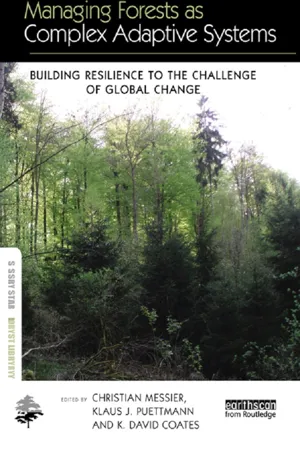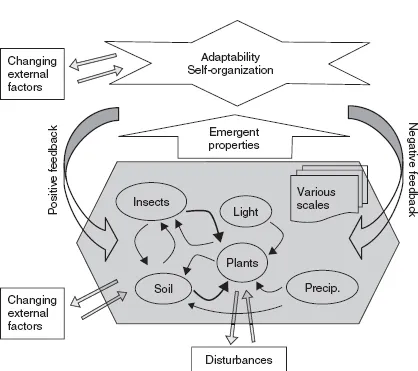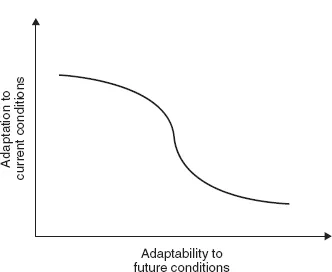![]()
Part I
Setting the stage
![]()
1 Managing forests as complex adaptive systems
Introductory concepts and applications
Klaus J. Puettmann, Christian Messier and K. David Coates
A new conceptual model of forest ecosystems
Bring eleven internationally reknowned forest ecologists together with some experts on complexity, lock them for three days in a peaceful countryside environment and challenge them to consider a new conceptual framework as a way to think about their field and their forests, then watch the results unfold over two years. This is what this book is offering you: a new way of thinking about forests and forest managements all around the world. From the unregulated forestry of Borneo to the highly regulated forest management of Finland, from the seemingly depauperate life of the boreal forest of Canada to the challengingly diverse forests of the Amazon, or through the incredibly human-manipulated Mediterranean forests, this book takes you on a journey of rediscovering the forest and how we could better manage it through the lens of complexity science. We all know that forests are ‘complex’ (in the ordinary sense of the word, meaning complicated, variable, diverse and heterogenous). This book and its various authors are attempting to demonstrate that this ‘complexity’ could be made to work for us instead of against us; that complexity (in the sense of complexity science) does not necessarily equate with our ordinary use of the word ‘complex’; that not every aspect of complexity science has to be complicated; and that forest managers and conservationists need to reconsider their emphasis on stability and predictability to allow the forest to adapt to – and self-organize for – the new conditions which we are creating through our actions.
Humankind has a long history of managing forests for a wide and everchanging variety of social and economic needs that reflect the progress of human social, political and economic systems. To accomplish this, traditional forest management has often strived for order and predictability for each and every stand (Puettmann et al., 2009). In an increasingly uncertain world, management based on an expectation of order, predictability and the replication of earlier successes is fraught with risk. In his review of our previous book, Peter Reich noted that ‘Given that forests cover one third of the terrestrial globe and play critical roles in the earth system, terrestrial biomes and human economy, it is imperative that we constantly improve our approach to the science and practice of forest management’ (Reich, 2009, p. 807). This book is the next step in our attempt at continuous improvement.
The notion of forests as complex systems is a logical extension of our changing view of forest dynamics. We believe forestry will be more effective if it adopts key concepts of complexity science and that the time has come to view forests and manage them as complex adaptive systems, for several reasons. First, the shift from the dominance of a single management objective, mostly wood production, towards the provision of multiple, often contradictory, objectives, opens the door to a less controlled and focused management paradigm. Second, increased future uncertainty due to global change, especially the effects of invasive species and climate change, requires a more flexible approach to managing our forests. Third, complexity science has now matured in other disciplines and is providing useful approaches to managing applied systems, such as transportation networks and business innovation cycles. Last, but not least, we believe that involving forest practictioners can help shape the future development of complexity science by ensuring that the vital role that forests play in the biosphere is better understood. The rest of this book expands upon these ideas about managed and unmanaged forests of the world.
Thinking of forests as complex systems is a relatively recent development in the fields of ecology (Levin, 2005; Green et al., 2006; Solé and Bascompte, 2006), silviculture (Puettmann et al., 2009) and forest management (Campbell et al., 2009). A major attraction of complexity science is that it provides a conceptual framework to promote the long-term productivity, biodiversity and adaptability of forest ecosystems and an integrative multidisciplinary approach to studying the structure and dynamics of forest ecosystems. It calls for a shift from the pursuit of specific stand-scale objectives toward a more flexible multi-scale perspective that considers site-, stand- and landscape-scale processes and their interactions. It acknowledges variability and uncertainty in environmental, biological, economic and social conditions.
Our objective in this book is to present views of many different forests and management approaches, from intensively managed plantations to highly diversified natural forests, through the lens of complexity science. The chapters that follow will describe how this view can be helpful in the design and implementation of management and research activities that maintain productive and fully functional forest ecosystems, especially in the context of an uncertain future. With their ability to self-organize and change over time, forests are different from strictly physical and chemical complex systems (Anand et al., 2010). Forests have ecological attributes – such as diversity, cross-scale interactions, memory and environmental variability – which make them not just complex, but also adaptive systems (Holland, 1992; Levin, 2005). This book provides examples of how managing forests involves the interaction of a vast number of ecological and socio-economic drivers within and across a wide range of spatial and temporal scales.
Forests as complex adaptive systems
The first major treatises directly discussing biological systems and forests as complex adaptive systems were Holland’s Adaptation in Natural and Artificial Systems (1992) and Levin’s Fragile Dominion (1999). Several books have followed, focused on specific aspects of complex adaptive systems. Camazine et al.’s Self-Organization in Biological Systems (2001) focused on self-organization and feedback loops and how these mechanisms allow fairly simple rules to generate the intricate and complicated patterns found in living systems. Solé and Bascompte’s Self-Organization in Complex Ecosystems (2006) explored quantitative aspects of the concepts covered by Levin, Camazine and co-authors. Scheffer’s Critical Transitions in Nature and Society (2009) and Solé’s Phase Transitions (2011) focused on thresholds and the ability to predict these in time to make management changes. While much of the work focused on biological systems in general (with an apparent emphasis on lakes), we proposed applying these concepts to forests and forest management (Puettmann et al., 2009). At the same time, Scheffer and other authors placed increasing emphasis on the human component in management of ecosystems, expanding the scope of their work from biological systems to socio-ecological systems (e.g. Norberg and Cummings, 2008; Waltner-Toews et al., 2008; Chapin et al., 2009).
Complexity science has a strong conceptual foundation that is based on work in numerous fields. It is not a discipline per se, but a set of theoretical frameworks which can apply to biological, economic, social and political problems and challenges. A complex system is adaptive when individual components are constantly reacting to one another and outside influences, thus continually modifying the system and allowing it to adapt to altered conditions (Figure 1.1). Complex adaptive systems are not well understood using the classical or Cartesian modes of thinking used in reductionist or determinist science (Gershenson and Heylighen, 2003). Reductionist science focuses on the study objects by investigating individual components in isolation. In contrast, complexity science suggests that a system can be better understood or managed by focusing on the interactions among the various components of the system. Viewing and managing forests as complex adaptive systems does not require developing a whole new set of theories and concepts. These topics are explained in more detail in Chapter 2.
Figure 1.1 Example of the components and interactions that highlight forests as complex adaptive systems. Adaptability and self-organization are the major aspects of system behaviour. (Modified from Puettmann, 2011.)
Forests exhibit all characteristics of complex adaptive systems (Chapin et al., 2009; Puettmann et al., 2009; see also Box 1.1). They are heterogeneous, highly dynamic and contain many biotic and abiotic elements which interact across different levels of organizations with various feedback loops. Changes in forest dynamics are driven by bottom-up linkages and interactions that bridge temporal, spatial and hierarchical scales. Such interactions can be circular, non-linear or exhibit threshold behaviours and they can be influenced by random events. Dynamic changes, not stable equilibria, are the rule, rather than the exception.
Managing forests from a complex systems view calls for emphasis on the adaptive capacity of ecosystems while acknowledging that uncertainty is the rule rather than the exception. Forest managers must consider and evaluate the short- and long-term viability of specific practices in a framework that minimizes risk and reduces the chance of undesirable future outcomes.
Box 1.1 Forests fit the definition of complex adaptive systems because they possess the following properties:
1 They are composed of many components (trees, vertebrates, insects, fungi, soil, etc.) and processes (nutrient cycling, seed dispersion, tree mortality, decay, etc.).
2 These components and processes interact with each other and with the external environment in many different ways and over multiple spatial, temporal and hierarchical scales.
3 These interactions can give rise to heterogeneous structures and nonlinear relationships.
4 These structures and relationships are neither completely random nor entirely deterministic, but instead represent a combination of randomness and order.
5 They contain both negative and positive feedback mechanisms, which stabilize or destabilize the system, depending on conditions.
6 They are open to the outside world, exchanging energy, materials and/or information.
7 Their development is sensitive to the initial conditions and memory following a major disturbance and subsequent changes.
8 They contain many adaptive components and subsystems nested within each other, giving rise to emergent properties – novel events that cannot be explained by studying individual forest elements or components.
Foresters, ecologist and wildland managers have struggled to understand how diversity in all of its forms affects the goods and services provided by forests. Today, we recognize that broad sets of stand structures (e.g. the species of standing live and dead trees, other plants and the presence of downed wood above and below ground) help to maintain the productivity and biodiversity of forests (Bauhus et al., 2009; Chapin et al., 2009). The role of disturbances in forest ecosystems in this context has also received extensive attention worldwide (e.g. Haeussler and Kneeshaw, 2003).
Forest managers have an intriguing challenge. On one hand, they can’t ignore the current need for efficient production of ecosystem goods and services, including timber production. On the other hand, new findings in complexity science and other trends make it more and more obvious that they increasingly have to address the forests’ ability to adapt to new conditions (Figure 1.2). Many traditional and recently evolving management approaches, such as those discussed in the various chapters in this book, can provide useful insights in dealing with this tradeoff. At the same time, new sets of criteria and indicators, including measures of adaptability and ecosystem resilience (defined on pages 10–12) are needed to evaluate the success of policy goals in forests managed as complex adaptive systems. Thus, a combination of old and new tools and skills is likely to be necessary to meet these diverse and sometimes even contradictory policy and management goals. With this modified approach, forest ecosystems can be viewed as moving targets and, accordingly, management will need to be flexible, adaptive and experimental.
Figure 1.2 Conceptual relationships between adaptation to current conditions and adaptability to future conditions. The y-axis can be interpreted as efficient production of ecosystem goods and services, e.g. timber production. The x-axis can be interpreted as forests managed as complex adaptive systems with a high emphasis on self-organization and adaptability. The scale and exact shape of the relationship is unknown. Also, much work still needs to be done to develop specific criteria and measures, especially for adaptability.
Terminology chaos
The terminology used to describe complex adaptive systems can be confusing, in part due to different disciplines, such as physics, ecology, restoration and silviculture, using the same words but with different meanings. Here we highlight the importance of differentiating terms that at first glance appear similar (such as complex, diverse and heterogeneous) and describe how other terms that have many definitions, such as resilience, are being used in the book. Chapter 2 further explores these issues and we hope the discussion here and in Chapter 2 will make scientific discussions more efficient and useful.
Diverse, variable, heterogeneous, complicated or complex are common terms used to describe structures and processes in forests. These concepts are often implicitly used as an indicator of naturalness. In the ecological and forestry literature, these terms describe the varied ways in which forests, at all scales, are non-homogeneous. Diverse is used when the elements of a system are categorical, for example, species or functional traits. Variable and heterogeneous are used for elements, such as tree, log and gap size, whose properties are continuous. Heterogeneity is usually used to describe spatial attributes, whereas variability is used for both spatial and temporal phenomena. Otherwise, these three terms essentially mean the same thing – that the system has lots of different elements.
Diverse forests, and the term diversity itself, are most often associated with multiple species, especially tree species and or tree sizes (Box 1.2). In terms of tree species at least, tropical forests (Chapters 3 and 8) are more diverse than boreal (Chapters 5 and 11) or Mediterranean (Chapter 10) forests. But they are not necessarily more complex.
Box 1.2 The role of diversity
When viewing forests as complex adaptive systems, it may be misleading to simply count species. For one, counting species means only focusing on a single level, albeit a very important one, of the multi-scale hierarchical organization typical of a forest ecosystem. Also, not all species have the same value and impact on the ecosystem’s ability to adapt, resist or be resilient to an external disturbance or stress. A more mechanistic approach emphasizes the diversity of plant traits (Norberg and Cumming, 2008), by sorting plant traits into groups that relate to ecosystem functions, such as the means by which they acquire nitrogen (e.g. N-fixing species, arbuscular mycorrhizal species, ecto-mycorrhizal species). A second group of plant traits can influence an ecosystem’s ability to respond to changes (e.g. adaptations to survive and regenerate after wildfire). Further research may lead to other potentially useful groupings, but even...


